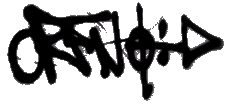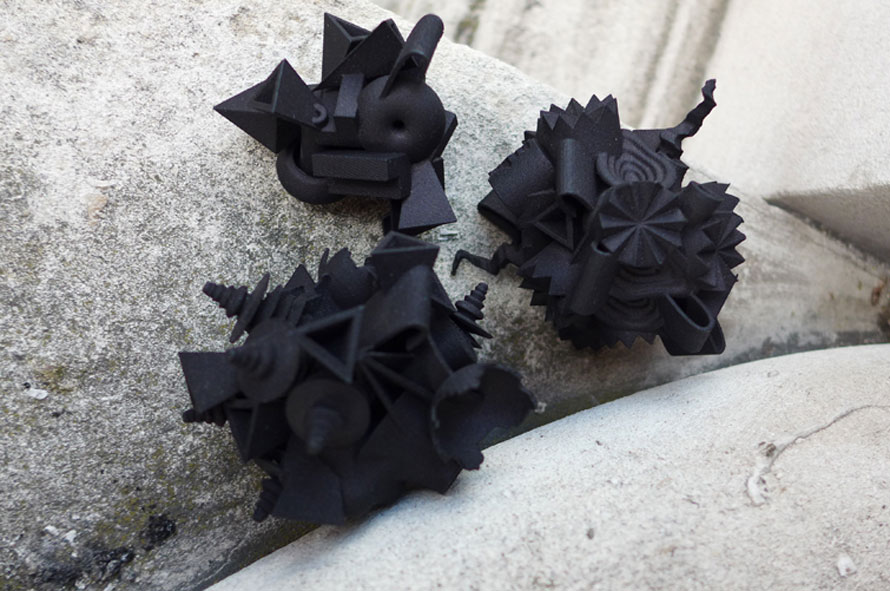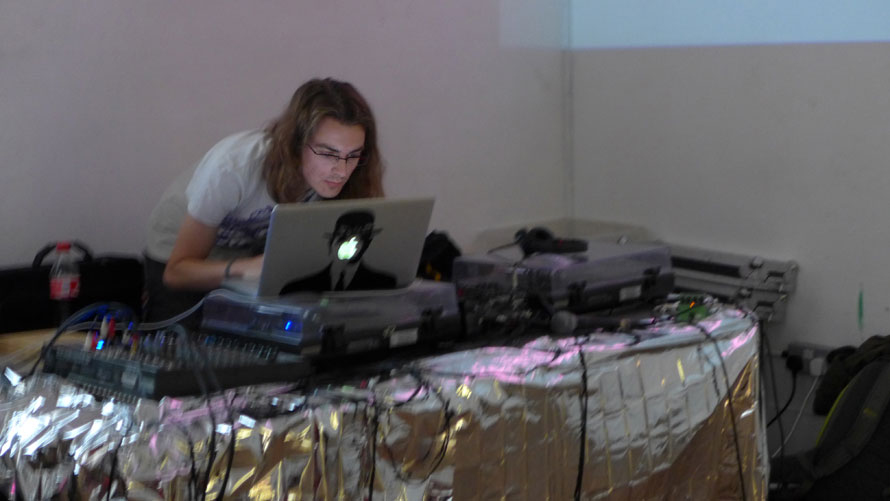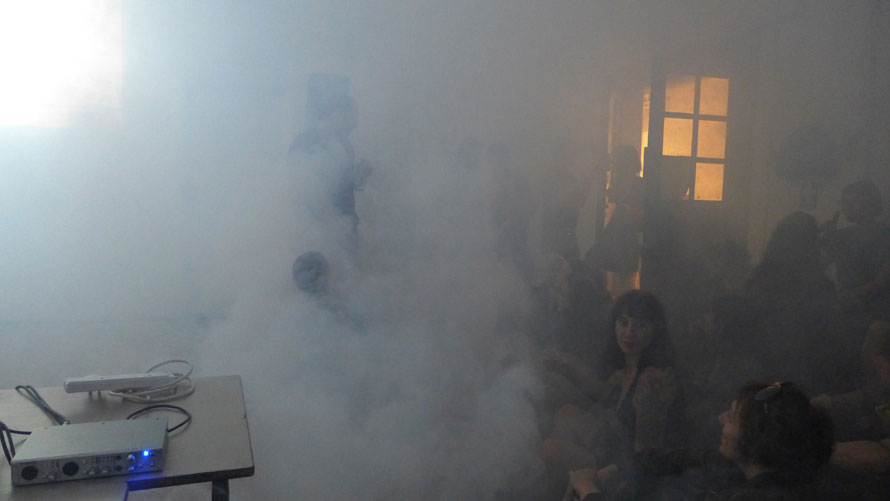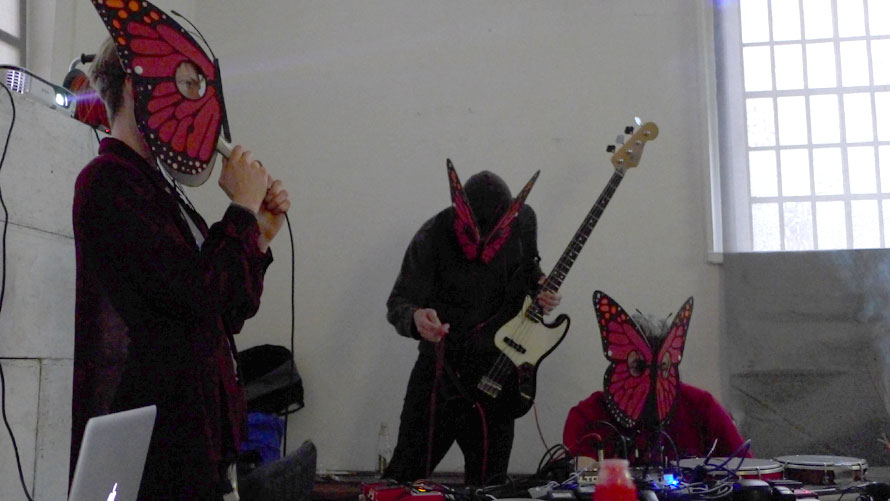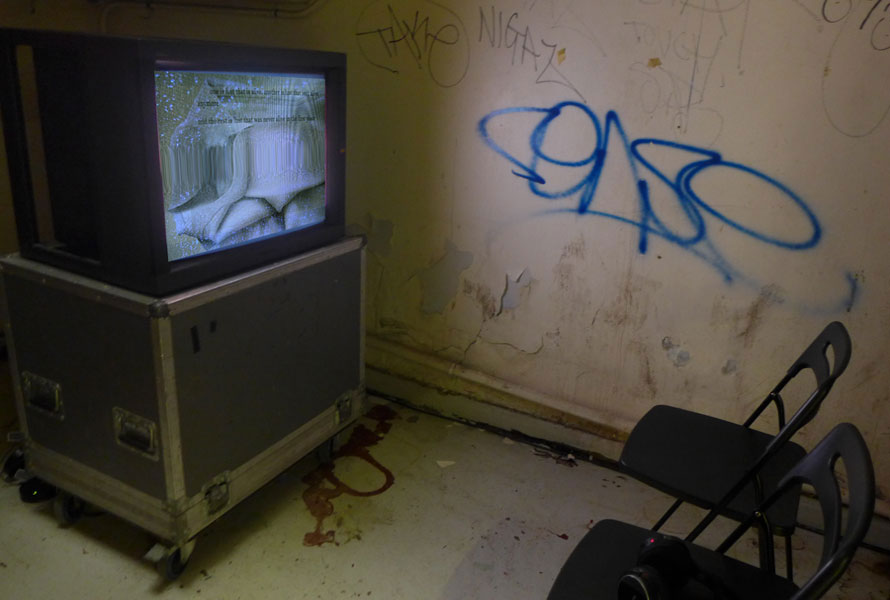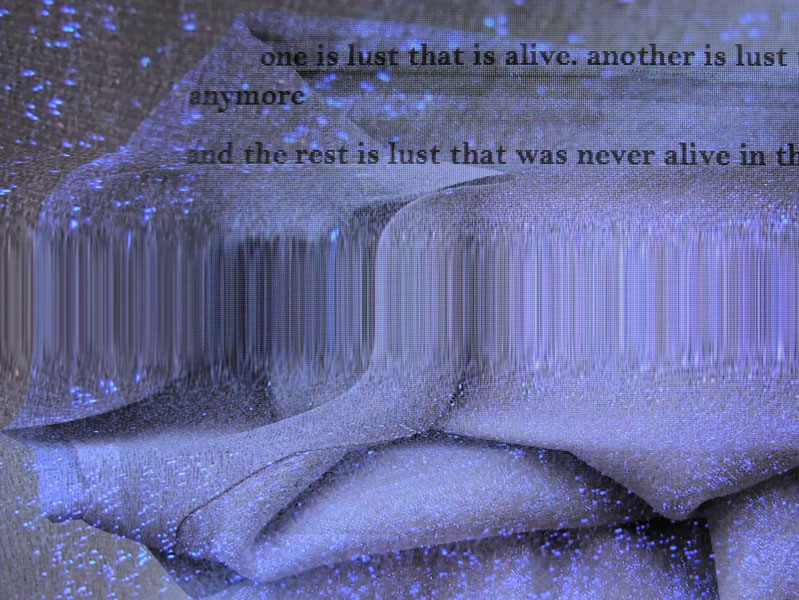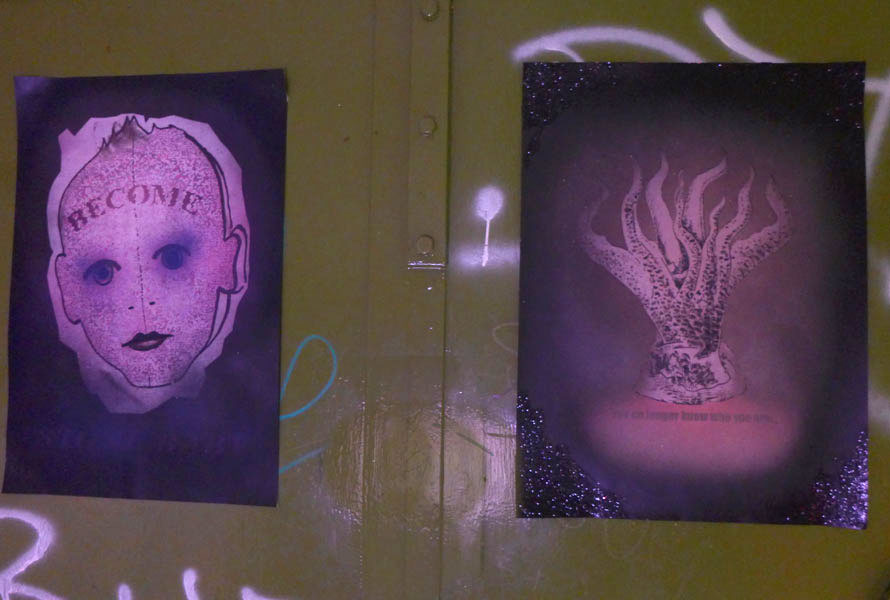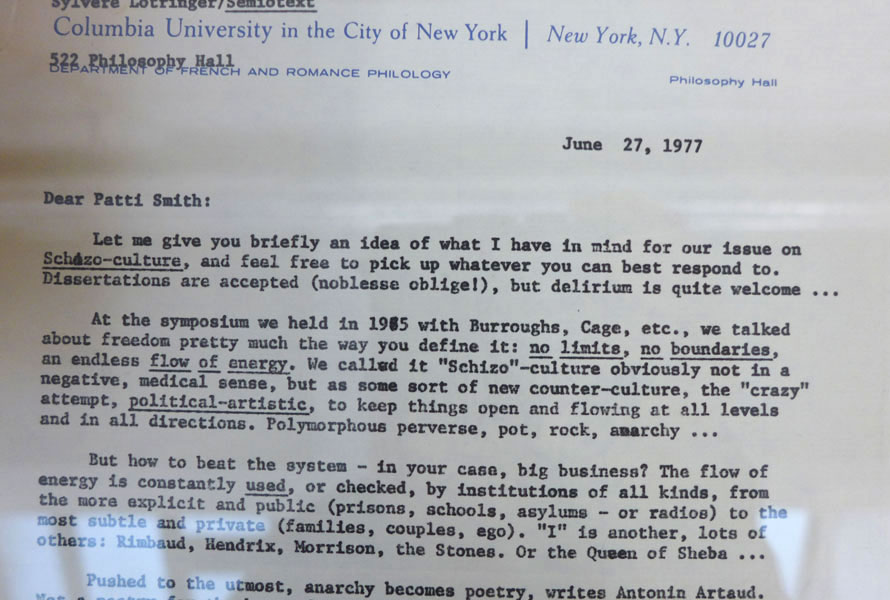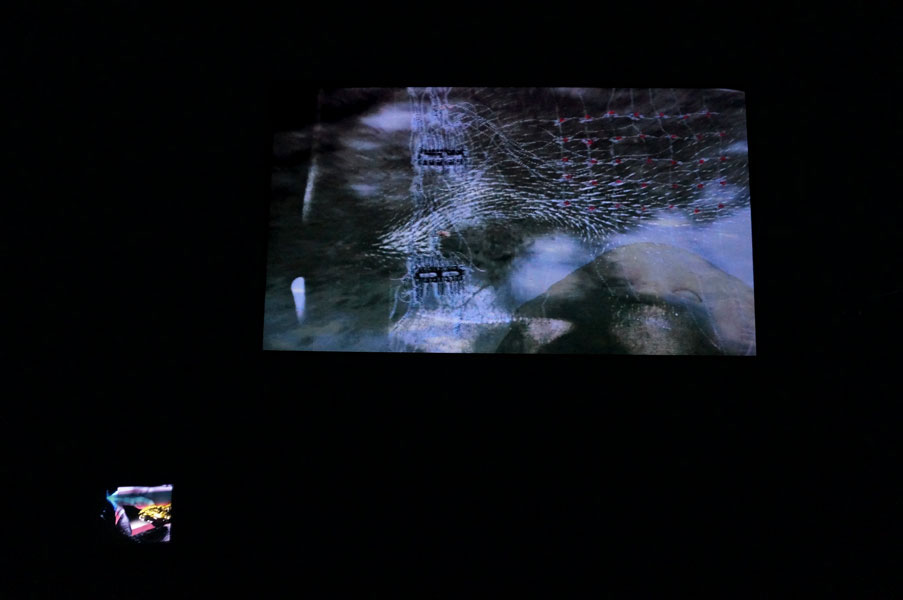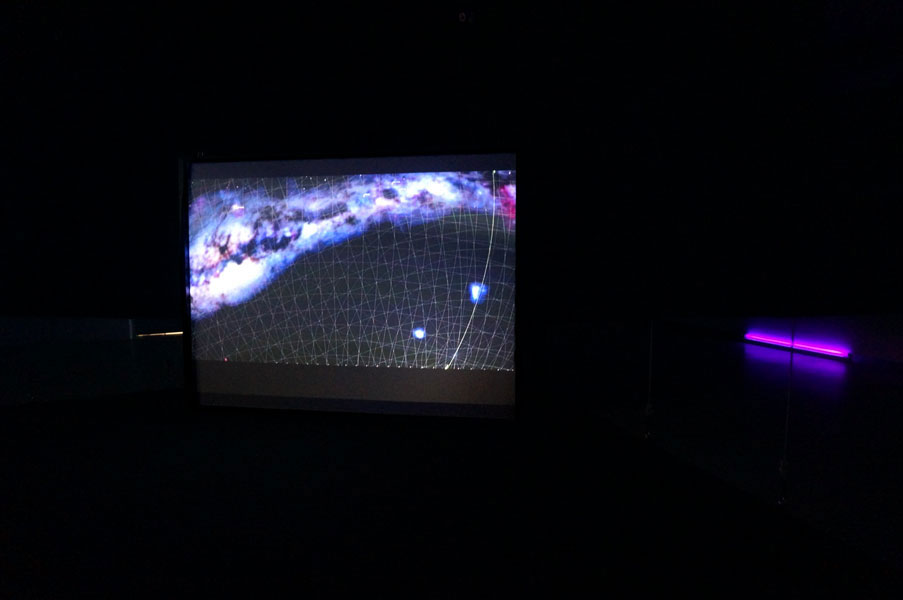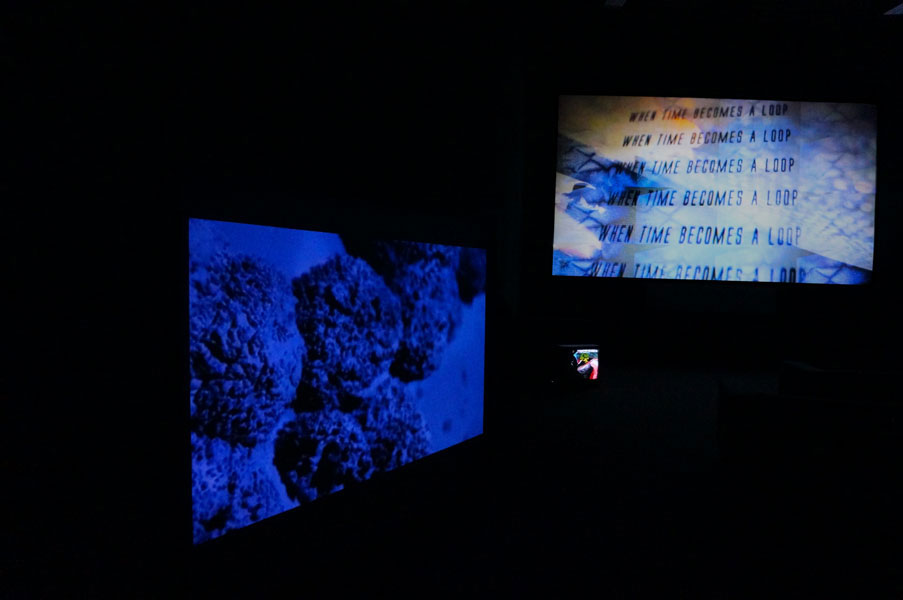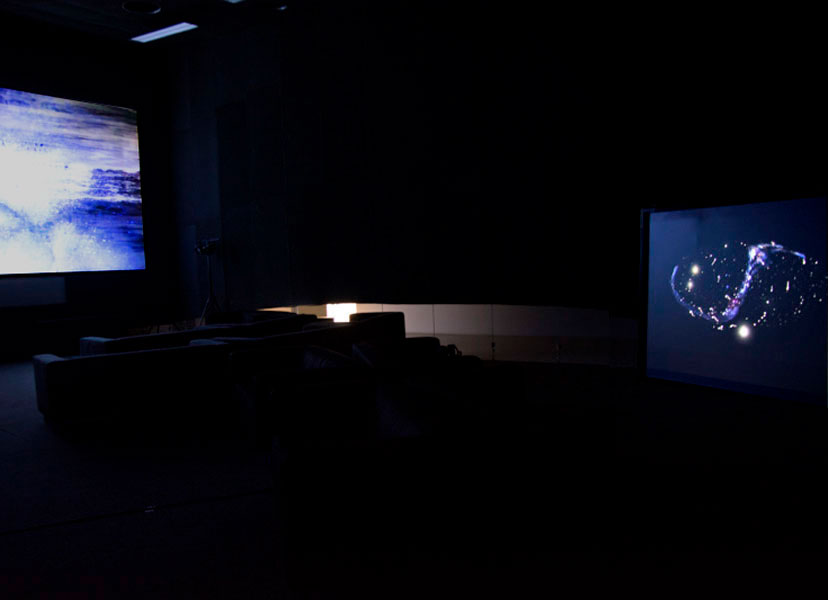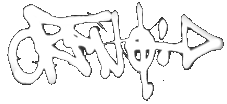Shadow Operators :: 2014
Video length: 30 minutes
The shadow of the thing arriving before the thing itself.
We have to attend to the impossible stories.
Shadow Operators was commissioned for Sounding The Counterfactual at Goldsmiths College in June 2014. The video was screened with work by AudInt (kode 9’s Steve Goodman) and Plastique Fantastique.
Shadow Operators also screened in the exhibition ‘Schizo Culture’ at Space Gallery, London 2014, along with work by CCRU and Plastique Fantastique then shown in ‘Grotto Heaven’, CAC Gallery, Vilnius, Lithuania. December 2014.
NB. If you don’t have sub bass speakers, there may be a couple of unexpected silent moments in the audio.
Excerpt from Shadow Operators on Vimeo
Shadow Operators :: Click an image to expand
Installation shots, ‘Grotto Heavens’, CAC, Vilnius, Lithuania. December 2014 :: Click an image to expand
Click on the title below to expand/collapse content
SHADOW OPERATORS
‘Shadow Operators’ is a sensory cross-talk (textual and spoken) of signals from realms beyond the physical, a succession of becomings mimetic, contagious and machinic. These intensities carry the sorcerous forces that technology and science unleash as they delve further into the quantum, the chaotic and the abstract. It is a synaesthetic, chromophonic work where trembling textures respond to the immersive soundscape. (Sub bass may not be audible, depending on your speakers). Collage imagery is embedded in the flow, reflections on 21st century hyperstitions. Suspension, overproximity, over exposure are tactics with which to dismantle the focused gaze. The liquid canvas conveys a space of infinite possibility and intensity, both a turbulent ocean and virtual entity. The work maps devices that operate between the finite and the infinite, the complex and the linear. Hyperstition is driven by speculation, trends and hype cycles that are culturally producing apocalypse. The Mechanosphere, the Anthropocene – the pace of technological and socio-economic change has amplified speculation as to where history is taking us. Accelerated superstitions have very real consequences. Technology has revealed the immense and un-human time scales of cosmic, geological and biological evolution, the existence of dark materials and energies, existence of further dimensions, the very mechanisms of matter and life. The ocean, filmed in myriad states of turbulence, then heavily and cumulatively effected, forms an abstract medium in which to embed these influences. The overall intention with this piece is to conjure an intense beauty with toxic reverberations that produces future shock and yearning for immersion in the viewer.
Shadow Operators explores the feeling of Hyperstition as an affective frequency. The current version is an audio and text driven work. Text is both embedded in the visual field and a spoken presence in audio.
Like A Wilderness Of Elsewheres, Shadow Operators consists of five sections, each with a distinctive frequency, audio and image content, here based on the elements of contemporary Hyperstition science fiction. Catastrophe, transformation, forge. Sound as a way to travel.
Perhaps we imagined the earth’s processes were linear… Habitat destruction, over population, over harvesting, pollution, ozone destruction, all are non linear. And work on each other in non linear ways.
The visual canvas is an intensely effected series of complex and increasingly turbulent fluid states which originate in close up footage of ocean movement, its rhythms and textures abstracted from their source and rendered virtual in substance, tactile, viscous. The sensation is of being overwhelmed by and dissolved in quantum currents, chaotic fields of the electromagnetic spectrum.
The text is generated from 0rphan drift performance and publications, my notebooks and Delphi Carstens Hyperstition phd. It becomes a shimmering embedded layer by being refilmed off a screen. Sampled documentary and scifi clips are similarly treated so that these elements merge with the fluid canvas. Allocated video filters applied to each section create a distinct artificial frequency. Content reappears mutated, transformed in temporality, direction, scale, opacity by the effecting presence. Hyperstition is a dimension of flux, a manifestation of the invisible and collapsed temporalities. It highlights uncanny, unpredictable patterns and attractors:
proliferations and die backs; storms, heatwaves, tsunamis, dust and wind, weather as monster; super bugs; excessive capitalism, radiation clouds from Fukushima, mercury levels in fish. This uncanny is also temporal – time oozes and undulates, concertinas and spreads. Events are always already happening. They are demonic in that through them causalities flow like electricity. Such vivid intimacy and a concomitant unreality. The intensity of their traces are unreal in their very luminosity. This searing clarity presents as clear unaffected photographs and collages that float on, rupture the dense textural ocean.
SOUNDING THE COUNTERFACTUAL: HYPERSTITION AND AUDIAL FUTURITIES @ LONDON CRITICAL
Stream organizers: David Cecchetto, Marc Couroux, Eldritch Priest
London Conference in Critical Thought, June 27-8, Goldsmiths, University of London.
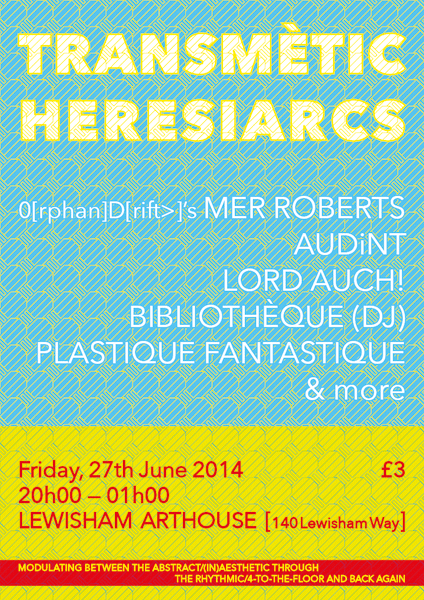 That sound and affect are fatally entangled should be obvious, for they share a primordial relation to a zone of indetermination between unconscious bodily impingements and their selective, conscious actualization. This is further suggested by the way sound’s im-mediacy and hearing’s continuous intake figure audition as a amenability to influenza of various forms that nudge virtual potentials towards predetermined outcomes. For contemporary cybercapitalist power, sound’s affective/infective nature plays a key role in ratifying its need to preserve homeostasis through a negative feedback that holds matter and information as equal realities. According to Anahid Kassabian, in a world of ubiquitous, networked technologies, music and sound are crucial vectors across which distributed-informatic subjectivities are constituted, a position advanced by the third wave of cybernetics wherein machinic, mediatic, and prosthetic ecologies have become indissociable from biological processes. Indeed, within this human/non-human commingling control operates virtually, nested within affective states that “unfold the past into the present” and inflect “the way the present acts on the past to unravel a new future.”
That sound and affect are fatally entangled should be obvious, for they share a primordial relation to a zone of indetermination between unconscious bodily impingements and their selective, conscious actualization. This is further suggested by the way sound’s im-mediacy and hearing’s continuous intake figure audition as a amenability to influenza of various forms that nudge virtual potentials towards predetermined outcomes. For contemporary cybercapitalist power, sound’s affective/infective nature plays a key role in ratifying its need to preserve homeostasis through a negative feedback that holds matter and information as equal realities. According to Anahid Kassabian, in a world of ubiquitous, networked technologies, music and sound are crucial vectors across which distributed-informatic subjectivities are constituted, a position advanced by the third wave of cybernetics wherein machinic, mediatic, and prosthetic ecologies have become indissociable from biological processes. Indeed, within this human/non-human commingling control operates virtually, nested within affective states that “unfold the past into the present” and inflect “the way the present acts on the past to unravel a new future.”
Hyperstition, a term coined by the Ccru (Cybernetic Culture Research Unit) and most often attributed to its chief ideologue Nick Land, is a useful point of intervention within a system that suppresses contingency, futurity. According to Land, “hyperstitions by their very existence as ideas function causally to bring about their own reality…transmuting fictions into truths.” Such a formulation is exemplified by finance capitalism’s investment in fictional entities such as futures and derivatives to compose an abstract but no less real dimension of profit. However, the manner in which the power of the virtual has been exploited by inhumanist capital to bring about the reality of a speculative profit—as in branding’s sorcerous implantation of false memories and future desires, which rewire the very notion of lived experience—points to the promise of hyperstition as producing counterfactual lines of actualization that compel the world to unaffordable futures.
How might sound (noise = rumore (It.) = rumor), the virological, immanent medium par excellence—acoustic space as networked space—be productively leveraged for its capacities to induce, bend, and channel affective potential? How might the effective powers of fiction be sonically enacted? How might spatial redistributions of mobile electronic sound galvanize emergent social and political structures?
Papers that grapple with these questions are welcomed, especially (but not exclusively) pertaining to the following areas of investigation:
– Sonic, technological, vibrational intervention: tactics / strategies.
– Science-fiction scenarios productively intermingling sound and futurity.
– The relation of sound to virality and emergence: how the molar might be engendered by the molecular.
– Technological prosthetics: how an alien phenomenology might be sonically leveraged.
– Sound and neurological processes: psychoacoustic neuromarketing (audio branding), priming, etc.
– New forms of listening (distracted, marginal, algorithmic, molecular, paradromic, pareidolic, machinic, infrasonic, telepresent) fostered by distributed, networked technologies.
– Techno-magical operations: confluences between occult procedures and bleeding-edge technologies.
– Rhythmanalytical modalities in algorithmic, computational cultures.
– Sonic accelerationism: auditory catalysts to induce alternative modernities and new socio-political formations (swarming, crowdsourcing, local-global transversals, viral processes).
Music’s amenability to cybernetics is underlined by Claude Shannon, who defined a “singing condition” as the inability of an automata to recognize its loopy entrapment. Music’s particular affordances, vitalities, and teleological necessities could serve as a model to help ensure a preordained future through the transformation and regulation of extra-musical sound, channelling the impersonal, inhuman death drive (positive feedback) into homeostatic equilibrium (negative feedback). Noise, far from being a nuisance to such cybernetic systems, is in fact essential to periodically restart them. How might an effectively transgressive practice operate given the alien, invasive neuro-military-entertainment avant-garde; what hyperstitional, paradromic methods might hijack and mutate uncommitted affective excess, escaping the reach of capitalist territorialization? This event is intended as a conversation probing the multifarious linkages between music, affective modulation and chronoportation.
Further details are available here:
http://www.thelondongraduateschool.co.uk/blog/marc-couroux-sabotage-the-audiostat-hyperstitional-paracoustics-chronoportational-pragmetics
SPACE PRESS RELEASE
SCHIZO-CULTURE – CRACKS IN THE STREET
03/10/14 > 07/12/14
SPACE is proud to present an exhibition and event series taking the seminal 1975 event: Schizo-Culture: On Prisons and Madness as its point of departure.
Organised by the early Semiotext(e) group – then comprising Sylvere Lotringer and John Rajchman – whose mission statement was to ‘bring together two continents of thought through a revolution of desire,’ the 1975 Schizo Culture conference saw counter-cultural icons such as John Cage, William S. Burroughs, R.D. Laing and Ti-Grace Atkinson come head to head with figures now regarded as some of the most influential thinkers of the 20th century: Michel Foucault, Jean Francois Lyotard, Gilles Deleuze, and Felix Guattari.
Cracks in the Street will feature new exhibition and performance commissions by Silvia Maglioni and Graeme Thompson (Terminal Beach), Sidsel Meineche Hansen, and Susan Stenger, alongside recordings and ephemera from the original 1975 event and the Semiotext(e) archive (courtesy of Fales Library and Special Collections, New York). Also featuring contributions by 0rphan Drift and Plastique Fantastique.
Curated by David Morris and Katherine Waugh in collaboration with Paul Pieroni/SPACE. Supported by Arts Council England.
More here: http://www.spacestudios.org.uk/whats-on/exhibitions/schizo-culture-cracks-in-the-street
THE OCCULTURE
The Occulture (David Cecchetto, Marc Couroux, and Eldritch Priest) presents:
Tuning Speculation II: Auralneirics and imaginary networked futures
7-9 November, Toronto (Canada)
ARRAY space, 155 Walnut Avenue
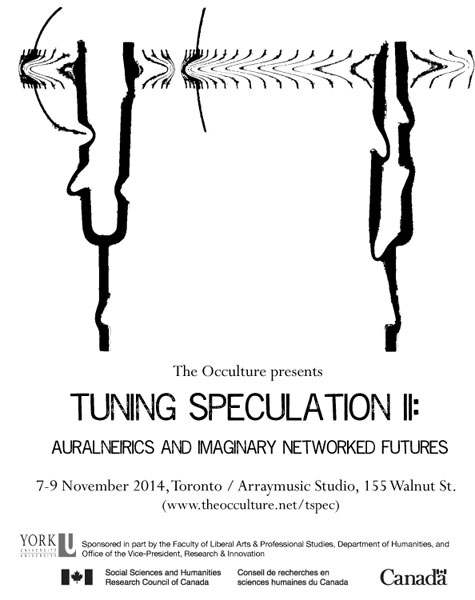
Plenary Speakers: Frances Dyson, Nandita Biswas Mellamphy and Dan Mellamphy
In the context of ubiquitous media not only is the sheer volume of data notable, but so too are the ways in which we encounter, interact with and articulate its abstract mass. This is particularly significant where contemporary social experiences are increasingly interpellated by a technical apparatus in a way that makes the former available only through the invention and deployment of extra-sensory algorithms. The implication of technology in human activity (while always present) in this instance raises new challenges, for the algorithmically negotiated data-bloom of digital networks intensifies the problem of agency by distributing its expression across material and virtual domains that belong to both organic and inorganic systems, as well as actual and fictional entities.
Building on last year’s meeting, this three-day workshop seeks to examine how aurally inflected mediations might address the complexities of agency and its relation to the counterfactual when one’s actions, feelings, thoughts, competences, desires, failures, and daydreams are implicated in the self-adjusting operation of nonlinear networks. For instance, we are interested in the ways that aurality conjures alternative sensitivities to data flows and rhythms of change that allow for both increased agency in existing networked settings but also for the envisaging and summoning of new vectors of agency itself. While several approaches can catalyze such speculations, we propose to concentrate on sounding art—broadly understood—in order to leverage the fated semiotic parasitism, differential production, relational expression, and perceived multiplicity that informs such practices. However, alongside such concentrating we also welcome various reflections on sono-distractions, phonochaosmosis, rhythmanalysis, harmelodic-prescience, audio pragmètics, chronoportation, h/Hypermusic and other invocations of impossible and/or imaginary networked aural futures.
Participants: Mitch Akiyama (Can), Lendl Barcelos (UK), G. Douglas Barrett (USA), Marcus Boon (Can), Geraldine Finn (Can), Paul Hegarty (Ireland), Ted Hiebert (USA), Eleni Ikoniadou (UK), Jonathan Scott Lee (USA), Nicola Masciandaro (USA), Svitlana Matviyenko (Can), Magdalena Olszanowski (Can), Ashley Scarlett (Can), Nikki Cesare Schotzko (Can), Marcel Swiboda (UK), Doug Van Nort (Can), Michael Vertolli (Can), Alexander Wilson (Can), Scott Wilson (UK), Martin Zeilinger (Can).
Special performance Saturday night, 9 PM : Paul Hegarty and Guests!!!
The schedule is online.
The entire three days will be streamed online. Live tweets will appear throughout the workshop under @xenopraxis. Stay tuned to The Occulture for details.
All welcome!
Marc (for the Occulture)
GROTTO HEAVEN PRESS RELEASE
A videoscape by Margarida Mendes with works by 0rphan Drift, Jol Thomson, Nate Boyce, Diogo Evangelista, André Sousa, Serafin Álvarez, Laleh Khorramian, Trygve Luktvasslimo+Fredrik Strid.
December 2014 at CAC Cinema
As the winter darkness peaks, visions of possible futures announce themselves: deteriorating cyber-landscapes collapsing into erupting lava, occult planetary formations merge into new data-matter systems, encrypted scenarios emerge as coral-like structures; sulphur and sweaty hardware.
This event takes the format of an ambivalent wonder.
While drifting through immersive world views and celestial formations, a polyphony of voices disclose epidermal plateaus and disassembled neuronal systems. Cells mutate and transform into new entities, infinitely consumed by their own metabolisms. Decomposed minerals are rewired into new interchangeable units. The nerval subtraction of the skin deteriorates into drinkable liquid. Cosmology reiterates itself and existentialism is molecularly navigated.
Grotto-Heavens is the first act of a series of events included in Catastrophe Cabaret, a programme speculating about possible futures in an era of predicted extinctionism. Contesting the general pessimistic view that dominates the topic, this project takes the overlap of absurdism and science fiction as an essential catalyst working towards self-representation, leaving us with the following qualms:
How do we envision our bodies in the unforeseeable post-catastrophic material world?
How will we choreograph the cognitive sensoriality of the future?
Margarida Mendes has directed The Barber Shop project space in Lisbon since 2009. She has a Masters in Aural and Visual Culture from Goldsmiths College of Arts in London. Specific research interests include materialist philosophy, cybernetics and experimental film.
“Grotto Heavens” is a contribution to the programe of events of the pilot project of the XII Baltic Triennial, “Prototypes”.
